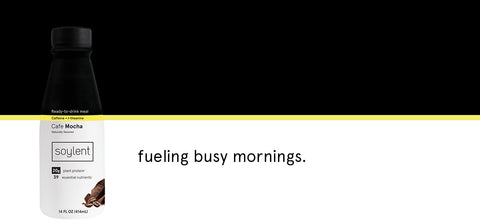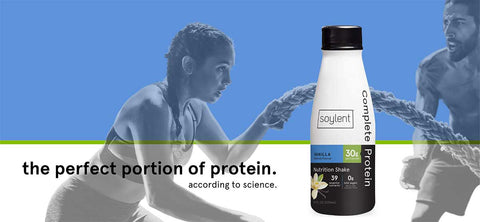
TL;DR
Protein gives you energy. And...
The whole story.
Does protein give you energy? Yes. What else should you be consuming in addition to protein to get the most energy out of your meals? What other roles does protein play in your wellbeing? These are even better questions.
Protein orchestrates a number of critical functions in your body, one of which is providing energy to your muscles. However, energy production is not protein’s primary role. So, how does your body draw energy from protein and what can you eat alongside protein to feel energized much faster?
Protein in the body

In our blog “What makes a protein shake healthy”, we pointed out how, rather remarkably, between your organs, muscles, tissues, bones, skin, and hair, there are over 10,000 types of protein present in your body.
Protein is used to build and repair muscles, strengthen bones, boost the immune system, diminish food cravings, support heart health, and heal inflammation and injuries. Protein is a powerful Swiss army knife of human body repair, handling more important things than we can keep track of.
When you eat protein-rich foods, your body first begins by breaking proteins down into smaller chains of amino acids, eventually turning them into individual amino acids. These amino acids are shuttled through your bloodstream to other parts of the body where they act like worker bees to start building muscle and repairing tissue. (This is also why it is important that you consume “complete” proteins - like soy - that have all of these amino acids.)
In this way, protein provides energy to your muscles by rebuilding and repairing them so they can function properly and carry you through the motions of your life.
But protein won’t work like a cup of coffee to jolt you into an energized state. As caffeine is a stimulant and has an immediate effect on your brain, in contrast protein provides sustainable energy to your muscles and full systems, but it takes much longer.
Need a quicker source of energy?

Carbohydrates like breads, grains, fruits, vegetables, milk, yogurt, and other starchy or sugary foods are what supply your body with immediate, burnable energy. Additionally, meal replacement shakes can be a quick and efficient way for athletes to get energy and nutrients.
Just like how your body breaks protein down into amino acids, it breaks carbs down into glucose, which is used as energy in your cells. If you want to get into the science behind how fast that happens that is how the glycemic index is calculated.
Chemically, glucose and amino acids are fairly similar. The difference is in the nitrogen content between the two. Because amino acids are high in nitrogen, it takes longer for your body to remove the nitrogen and convert them into energy. This is why you shouldn’t lean on protein as your primary source of energy.
In fact, your body will only begin using amino acids for energy if it’s completely out of glucose from carbs and fatty acids. If you consume enough carbs and fats throughout the day, and if you have fat stored up, your body may never need to turn protein into energy at all.
Eat wise when you exercise

There’s a reason triathletes reach for a monstrous bowl of spaghetti marinara the night before a big race, and it’s not because they’re just craving Italian.
While your body can use fatty acids for energy in a resting state, when you’re in an active state, like running or exercising, it depends on converting carbs into glucose for immediate fuel. If you’re engaging in any form of intense physical activity, you want to have carbs present in your body that will fuel you properly throughout your workout.
If you don’t have glucose stored up from carbs, your performance will be seriously compromised. This is what many athletes refer to as the “bonking effect” or “hitting a wall”. The reason you feel like you just got a flat tire is because your body now has to burn lean muscle or fat for immediate energy.

Burning lean muscle isn’t good because it lessens your overall strength and endurance, and you worked too hard for that muscle to be burning it up in exercise! Your body can use fat for energy, but because it takes longer to convert, you won’t be feeling fueled as quickly or effectively.
Along with consuming carbs, you want to also be consuming ample amounts of protein to feed those tired, shaky muscles when physical activity comes to an end.
In a standard bottle of Creamy Chocolate Soylent, there’s a balance of 24 grams of fat, 36 grams of carbs, and 20 grams of protein. This balance is intentional and it is to maximize the functional benefit your body gains from the shake.
And for folks who want extra protein to recover following an intense workout, we packed 30 grams of complete plant-based protein into our Complete Protein shake.
Thoughtful macronutrient consumption
To feel well-fed and assure your body has all of its critical functions accounted for, you should aim to consume a balanced diet that is rich in protein, carbs, and healthy fats.
The National Institute of Health (NIH) published an article citing dietary guidelines for consuming macronutrients. For adults, they cited that 45% to 65% of their total calories should come from carbs, 20% to 25% from fat, and 10% to 35% from protein.
Of course, for those of you who exercise regularly, especially if you engage in regular strength training, you may want to consume slightly more protein to account for the increased need of muscle recovery, repair, and growth.
The NIH also notes how these guidelines are much more flexible than those of the past, which is helpful for people planning diets around varying goals or needs.
We discussed how carbs provide energy to your cells and how protein is used to build and repair muscle and tissue and handle many other functions in the body. What about fat? Fat is broken down into fatty acids that make cell linings and hormones. Extra fat is stored in fat cells.
An energizing ending

Life is a balance, right? While carbs are the most efficient and effective source of immediately burnable energy, you might not feel all that great in general if you aren’t consuming enough protein or healthy fats, either.
For those harrowing days when the clock ruthlessly skips ahead on you and planning your macronutrient consumption is painful at best and unimaginable at worst, keep a Soylent close by.
We’ve made sure our blend has healthy servings of all three macronutrients, along with 28 other vitamins and minerals, to keep your body chugging along nicely.
Stay alert, stay healthy, stay energized friends!





